 |
Native American Warbonnets
Warbonnets (or war bonnets) are the impressive feather headdresses commonly seen in Western movies and TV shows. Although warbonnets are the best-known type of Indian headdress today, they were actually only worn by a dozen or so Indian tribes in the Great Plains region, such as the Sioux, Crow, Blackfeet, Cheyenne, and Plains Cree. In the first photograph, you can see a Dakota Sioux warrior wearing a trailer warbonnet (native headdress with single or double rows of eagle feathers descending in a long 'tail' all the way to the ground). In the second photo, modern Crow elders attend a formal event in halo warbonnets (native headdresses with eagle feathers fanned out around the face in an oval shape). The third photograph shows a Blackfoot man wearing a straight-up feather headdress (taller, narrower headdresses where the eagle feathers stand up straight.) All three types of Indian war bonnets were made from the tail feathers of the golden eagle, and each feather had to be earned by an act of bravery. Sometimes a feather might be painted with red dye to commemorate a particular deed. Besides the feathers, Plains Indian warbonnets were often decorated with ermine skins and fancy beadwork.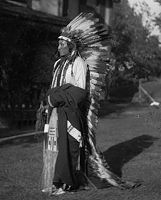 |
| trailer war bonnet |
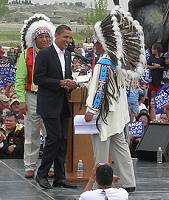

Native American warbonnets were important ceremonial regalia worn only by chiefs and warriors. Also, only men wore warbonnets. (Women sometimes went to war in some Plains Indian tribes, and there were even some female chiefs, but they never wore these masculine headdresses.) Plains Indian men occasionally wore warbonnet headdresses while they were fighting, but more often they wore roach headdresses into battle (see below) and saved their war bonnets for formal occasions. In particular, long feather trailers were never worn on the battlefield. It would be impossible to fight while wearing them!
In the 1800's, Native American men from other tribes sometimes began to wear Plains-style warbonnets. Partially this was because of the American tourist industry, which expected Native Americans to look a certain way. Partially it was because many Native American tribes were forced to move to Oklahoma and other Indian territories during this time in history, so tribes that used to live far apart began adopting customs from their new neighbors. In most cases, the feather warbonnet did not have the same significance among the new tribes that adopted it. For them, wearing a feathered headdress was a matter of fashion or a general symbol of authority. But for the Plains Indian tribes, feather warbonnets were a sacred display of a man's honor and courage, and each feather told a story. Eagle feathers are still sometimes awarded to Plains Indians who serve in the military or do other brave deeds today.
Roach Headdresses (Porcupine Roaches)
Feather warbonnets are better-known to popular culture, but roach headdresses (also called porcupine roaches or artificial roaches) were the most widely used kind of Indian headdress in the United States. Most Native American tribes east of the Rocky Mountains were familiar with some form of roach headdress. These native headdresses are made of stiff animal hair, especially porcupine guard hair, moose hair, and deer's tail hair. This hair was attached to a bone hair ornament or leather base so that it stood straight up from the head like a tuft or crest. Often the hair was dyed bright colors and feathers, shells, or other decorations were attached. In some tribes, men wore their hair in a scalplock or crested roach style (frequently given the name Mohawk or Mohican after two tribes in which roached hair was common), and the artificial roach was attached to the man's own hair. The Caddo man in the first picture is wearing his roach headdress this way. In other tribes, porcupine roaches were attached to leather headbands or thongs and worn over long hair or braids. This is how they are most commonly worn today.


Caddo warrior's roach powwow dancer's roach Indian roach for sale
Roach headdresses were usually worn by warriors and dancers. Like war-bonnets, the porcupine hair roach is traditionally men's headwear, not worn even by female warriors. Their use varied from tribe to tribe. In many tribes, roaches were worn into battle, while more formal tribal headdresses (like warbonnets, otter-fur turbans, or gustowah caps) were worn to ceremonial events. In other tribes, roaches were worn primarily as dance regalia or sports costume. In some tribes, individual men chose to wear porcupine roaches while other men did not. Like other clothing styles, roaches sometimes went into and out of fashion. They were not generally as spiritually meaningful as Native American warbonnet headdresses, though a boy earning the right to wear a roach for the first time was an important ceremony in some tribes. Today, porcupine roaches can be commonly seen at powwows, where they are still worn as regalia by male dancers from many different tribes.
Basket Hats
Basket hats (also known as twined caps or basketry hats) were the most common type of Native American headdress west of the Rocky Mountains. Different tribes made basket hats in different shapes and styles. California Indian tribes usually made small rounded or fez-shaped basket caps from tightly coiled sumac, like the Hupa Indian hat below. Northwest Coast tribes like the Haida and Salish often made larger hats in more conical or brimmed shapes from fibers such as cedar bark or spruce root.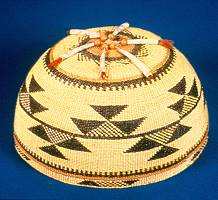


Hupa basket cap Haida basket hat Nootka whaler's hat
In California and the Plateau tribes, basket hats were normally worn only by women and girls, and their designs were mostly decorative. On the Northwest Coast, both men and women wore basketry headgear, for dance regalia and ceremonial purposes as well as everyday life. Northwest Coast basket hat designs often conveyed information about a person's clan, achievements, or status within the tribe.
Feather Headbands
The Indian headband is also well-known from movies and other popular images of Native Americans. However, this style of headband was typically only used by a few tribes of the northeast Woodlands. Usually the headband consisted of a finger-woven or beaded deerskin strip with tribal designs on it. This band was then tied around the brow with a feather or two tucked through the back. Not only eagle feathers but turkey, hawk, egret, and crane feathers were also used for Woodland Indian headbands.

Abenaki headbands Lenape Indian headbands
Unlike many of the Native American headdresses on this page, both men and women wore headbands, which were not associated with war. The number and type of feather did not usually have special symbolic meaning, though in a few tribes that bordered the Plains eagle feathers were reserved for warriors. For the most part, Woodland Indian head bands were worn for their beauty, and were often decorated with intricate patterns, wampum, beads, and quill work.
Buffalo Headdresses (Horned Warbonnets)
Like feather war bonnets, buffalo horn headdresses were traditional regalia of certain Plains Indian warriors. These were helmets of buffalo hide with a pair of buffalo horns attached, frequently adorned with shaggy buffalo fur and a buffalo tail trailing behind. In many cases ermine skins and war feathers were hung from the headdress, as in the second picture. Sometimes a horned headdress was even combined with a feather trail, as in the third picture.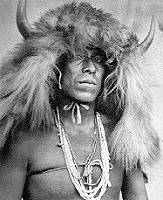
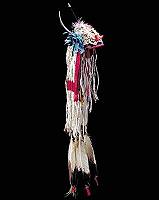

Sioux buffalo headdress Piegan horn headdress Buffalo warbonnet
The spiritual and ceremonial importance of horned headdresses to the Plains Indians was similar to that of feathered warbonnets. Only distinguished male warriors wore this sacred kind of regalia. Horned headdresses were rarer than eagle-feather warbonnets, because they were used by fewer tribes (only the Sioux and a few other tribes of the northern Plains wore this kind of headdress) and also because only warriors of certain clans or who had accomplished specific deeds wore bison horns.
Otter Fur Turbans
Otter-fur turbans (also known as otter-skin caps) are ceremonial headdresses worn by men in certain Prairie and Southern Plains tribes, such as the Potawatomi, Pawnee and Osage. These are round hats made of otter fur with the otter's tail either hanging behind or jutting out to one side in a beaded sheath. The turbans and tail sheaths were often elaborately decorated with beaded and painted designs symbolizing the owner's war honors, and a chief and his descendants usually attach eagle feathers to the back of their turbans.


Pawnee chief's turban Otter turban Otter cap with sheath
Otter-skin turbans were formal head dresses with great symbolic importance. They were worn at ceremonies or other solemn occasions, not by warriors entering battle (who usually wore porcupine roaches.) Even today, otter-fur caps are sometimes worn at formal events by Southern Plains Indian men.
Other Tribal Headdresses for Men



Iroquois gustoweh cap Hupa flicker headdress Seminole cloth turban
The gustoweh cap is a formal feathered skullcap used only by men from the Iroquois tribes. The big eagle feathers on top of the cap were symbols that showed which specific tribe an Iroquois man belonged to. (The three straight feathers on the cap in this picture mean that the owner is Mohawk.) In some northern California tribes, men wore flicker headdresses as dance regalia. These California Indian headdresses are made of wide leather strips decorated with the red scalps of woodpeckers. During the 1800's when cloth became more readily available, cloth turbans decorated with feathers became stylish among Cherokee, Seminoles and other southeastern Indian men, and cloth headbands became everyday wear for men from the Navajo, Apache, and Pueblo tribes.
Interesting - something else I never knew about.... CM
Very interesting! I wasn't aware there was so many variations of headdresses.
ReplyDeleteI thought that they wore the beautiful feather bonnet ones all the time. Good to learn something new!
DeleteWell researched indeed! I gotta link this.
ReplyDeleteThank you, CW. The buffalo war bonnets must be absolutely beautiful to see. I never knew hats were worn by some tribes.
DeleteMost well done. Thanks!
ReplyDeleteGlad you enjoyed the info, Mr. Townsend - Happy Thanksgiving to you and yours!
Delete